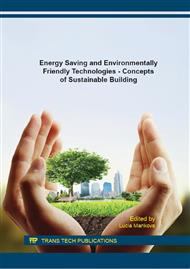p.323
p.331
p.339
p.347
p.355
p.363
p.371
p.379
p.387
Spreading of Temperature Field Caused by Microwave Radiation
Abstract:
Building construction drying using high-frequency electromagnetic radiation (EMW), or microwave technology (MW), is gaining more usage in practise. It is the quickest way of eliminating water content in construction (wall, ceiling, etc.). Microwave is a term for a part of the electromagnetic radiation of 300 MHz to 300 GHz frequency with a wavelength from 1 mm to 1 m. The frequency of 2,45 GHz and 122 mm wavelength is used for technical practice. Due to the effect of MW radiation a different homogeneity of temperature field can be observed.This article discusses the spreading of the temperature field depending on the water volume and thereby the amount of mass moisture of the material (silica fume). Temperature fields will be shown by the thermo camera at certain time cycles of heating.
Info:
Periodical:
Pages:
355-362
Citation:
Online since:
January 2016
Authors:
Price:
Сopyright:
© 2016 Trans Tech Publications Ltd. All Rights Reserved
Share:
Citation:


